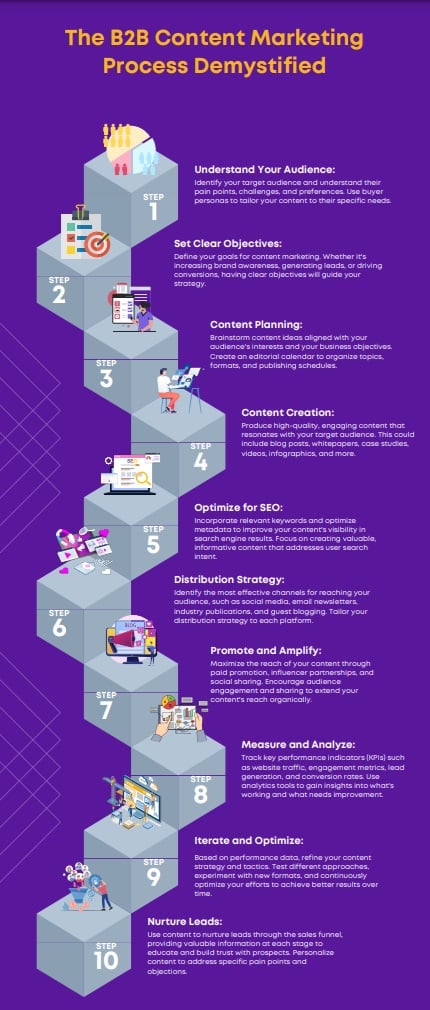The B2B Content Marketing Process Demystified: 10 Steps to Success
June 21, 2024
Content marketing is a crucial strategy in the digital landscape, and for good reason, especially in the B2B sector.
Its benefits are manifold: Search engines favor it for providing relevant answers to user queries, and, most importantly, users appreciate free and valuable information and are more likely to convert because of it.
Creating and sharing content demonstrates a company’s willingness to share expertise at no cost to the user, increasing the brand’s trustworthiness and approachability. Moreover, consistently delivering high-quality content enhances a business’s visibility and authority, driving it up the search engine results pages and making it more likely to be found.
However, it is essential that content be executed well. Poorly crafted content can damage a company’s reputation and diminish its perceived expertise. To that end, businesses should invest adequately in their content marketing efforts to ensure they deliver top-notch, informative, and engaging material.
If resources or time is lacking, a possible solution could be to hire a professional B2B writer or a content marketing service to help out. Either way, creating content should be a priority and not a last-minute endeavor.
Let’s take a look at the 10 most important steps in the B2B content marketing process.

Step 1: Understand Your Audience
Before you start creating content, it’s essential to know who you’re creating it for. Who is your audience and what problems (pain points) do they have that you can help them with?
Having a basic understanding of your audience is a start, but you need to go further than that. Continue finding as much information about them as you can, building up buyer personas, including their preferred social media platforms, general physical location, and education level.
This information will go a long way in helping you create content that resonates with your audience.
Step 2: Set Clear Objectives
Before jumping straight into creation-mode, take a moment to think about what it is that you want to achieve. It might sound superfluous, but starting the process with a goal in mind makes the end result much more impactful and ensures that your efforts aren’t diluted.
Clearly defined content goals can range from increasing brand awareness, generating leads, or driving conversions. Knowing what you want to achieve with your content makes it easier to come up with the type of content that is needed, as well as necessary keywords, Search Engine Optimization (SEO), and Key Performance Indicators (KPIs), which we’ll talk about later.
Step 3: Plan Your Content
Now that you know whom you want to reach and why you want to reach them, the next step is to brainstorm the kind of content most aligned with your goals and audience.

Draw up a content calendar and populate it with the different types of content you have in mind, combined with the most advantageous frequency.
Knowing how often to post content can be a challenge, and you might need to do a bit more digging to find the optimum times for each channel you wish to use.
Step 4: Create Your Content
Once you have a content plan, the real challenge begins. Creating content is an entirely different ball game from simply knowing what kind of content you need. Examples of content you might consider are blog posts, white papers, infographics, and even how-to videos.
To get started, you might find it useful to experiment with one of the many free resources available online. If you struggle with coming up with ideas, it might be beneficial to use an AI-powered program like ChatGPT to get you out the gate.
Using Natural Language Processing (NLP), ChatGPT can understand simple requests. For example, you might input a prompt such as the following: Imagine you are writing a blog for a natural industrial cleaning products company. Now, write a 500-word blog post about the benefits of using natural cleaning products.
ChatGPT and similar programs are not fool-proof, and you will definitely need to go over what they spit out, but it often helps to have something to edit rather than starting from scratch. (Click here for our take on the abilities and limitations of AI in content creation)
Alternatively, partnering with a professional writing service that has experience creating marketing content in the B2B sector might be very beneficial, as it takes all of the leg-work out of this challenging step in the process.
Whichever route you take, understand that the long-term ROI (Return on Investment) of content marketing comes from investing in content of consistent quality.
Step 5: Optimize for SEO
Search Engine Optimization (SEO) simply means strategically adapting your content in a way that search engines like Google will be able to find it.
When a Google user types in a specific search inquiry, it is up to the search engine to trawl the internet to find the content that will be most useful and valuable to the user.
It does this by analyzing your website using a specific algorithm, checking not only whether your content matches the keywords of the search inquiry, but also whether your website’s load time is fast and whether users have spent considerable time on your site in the past.
When it comes to SEO, a good place to start is to see that your website is up to standard.
For example, is your website mobile-friendly? SEO site plugins such as Yoast can help with the housekeeping that goes into making sure your website is easy to find and rankable for search engines.

When it comes to marketing content, SEO will also play a very important role. Remember that search engines track your content to see if it lines up with users’ search queries. To this end, it is important to include relevant keywords in your content to identify what it is about. We’re not saying oversaturate it—after all, there’s nothing worse than a clearly robot-created keyword-drenched piece of content on the internet.
The golden rule is to make your content findable by search engines, and above all useful, because then the users who do get it will stay on your site longer, thereby increasing your ranking on the search engine results page (SERP).
Step 6: Strategize Distribution
After you’ve created content, it’s time to strategize the dissemination of the content to your audience.
If you know your audience well, chances are you will have a pretty good idea of which social platforms they hang out on. Moreover, don’t forget about traditional channels such as email, as targeted email campaigns can be extremely effective.
With quality content, it is a simple process to adapt it to suit each platform. This might entail adding call-to-actions to snippets or quotes taken from your content, or perhaps matching your content with the right images in order to optimize it for visual platforms such as Instagram. (Check out this post on creating stunning visuals for your marketing using Canva.)
Content can be promoted across many different platforms and, as long as it is done well, the effort will be well worth it.
Step 7: Promote and Amplify
Once your content is completed and has been published, the next step is to promote and amplify it.
If you’ve made sure that your content is of a high quality, has good SEO, and holds value for the reader, chances are it will be found sooner or later. However, advertisements and even paid partnerships can be the catalyst your content needs to gain a wide audience and large reach in little time.
By promoting your content on social channels, there is a good chance it will land in front of a few people who would not have seen it otherwise. Similarly, paid partnerships offer you the opportunity to tap into an established and enthusiastic audience.
The end result is higher views and further reach, which helps increase your content’s ROI.
Step 8: Measure and Analyze
Once enough time has passed, it is essential to take a good look at your content’s metrics across your channels.
Each platform will have different KPIs (Key Performance Indicators), so it is important to get a good understanding of the platform and what to look out for. Once you understand your platform, come up with a set of metrics to measure your past and future content against consistently.
Examples of metrics to look out for on your website might be the following:
- Website traffic. How many visitors came to your website
- Engagement. Whether or not your content received any likes, comments, or shares
- Lead generation. Whether any users provided contact information by filling in forms or providing other information
- Conversion rates. The percentage of users who completed a desired action you had in mind for them, such as clicking on a call-to-action
- Bounce rate. The percentage of users who entered your website to view the content but left without exploring further
- Session duration. How long a user spent on your site
- Demographics. Where in the world your users are based
- Traffic source. How users came to your content—anything from directly typing in your website URL to following an advertisement on a social platform
Step 9: Iterate and Optimize
Understanding your content’s metrics means being able to improve where there is an opportunity.

By analyzing data and learning from it, your content marketing can only get better.
Once you have identified where your strategy is in need of an upgrade, it is a simple enough task to take what you have learned from your past performance and adapt it for future trends.
Existing content can be repurposed to fit current trends or upcoming appetites, without the need to reinvent the wheel.
Audiences don’t expect you to churn out brand-new content as the season changes; instead, it is perfectly acceptable to simply update and refresh what is already on your website.
That way, not only do you work smart but you work quickly as well.
Step 10: Nurture Leads
Last but most important, you want to ensure that all the leads captured through your content marketing strategy are properly nurtured and the data put to good use.
Capturing leads through effective digital content marketing means obtaining a wealth of information that can help move your leads further down the funnel. If done right, the whole process can be much swifter and more effective.
Knowing who your leads are means being able to personalize the process, addressing specific pain points they may have. AI can also be quite useful during this part of the process in that it is able to interpret vast swathes of data and categorize it according to customer types. AI can also be used to automate next steps and suggest follow-up content to users based on its algorithms.
The content marketing process may seem daunting at first, but it is an effective method to gain leads and further your marketing aims. By following our 10 steps, you can demystify the B2B content marketing process and unlock its full potential to drive business growth.
With the right strategy and execution, your content can become a powerful tool for attracting, engaging, and converting your target audience.































